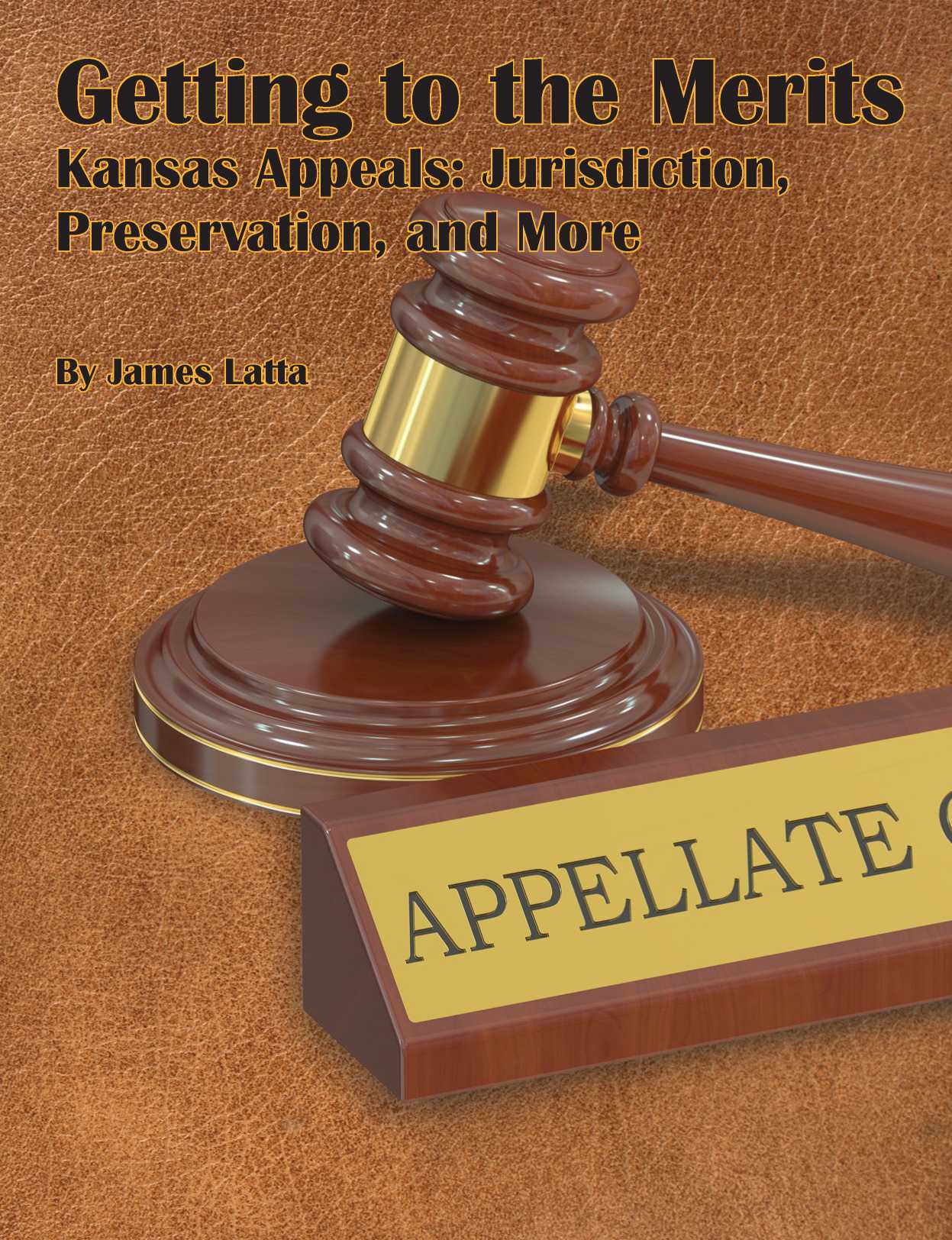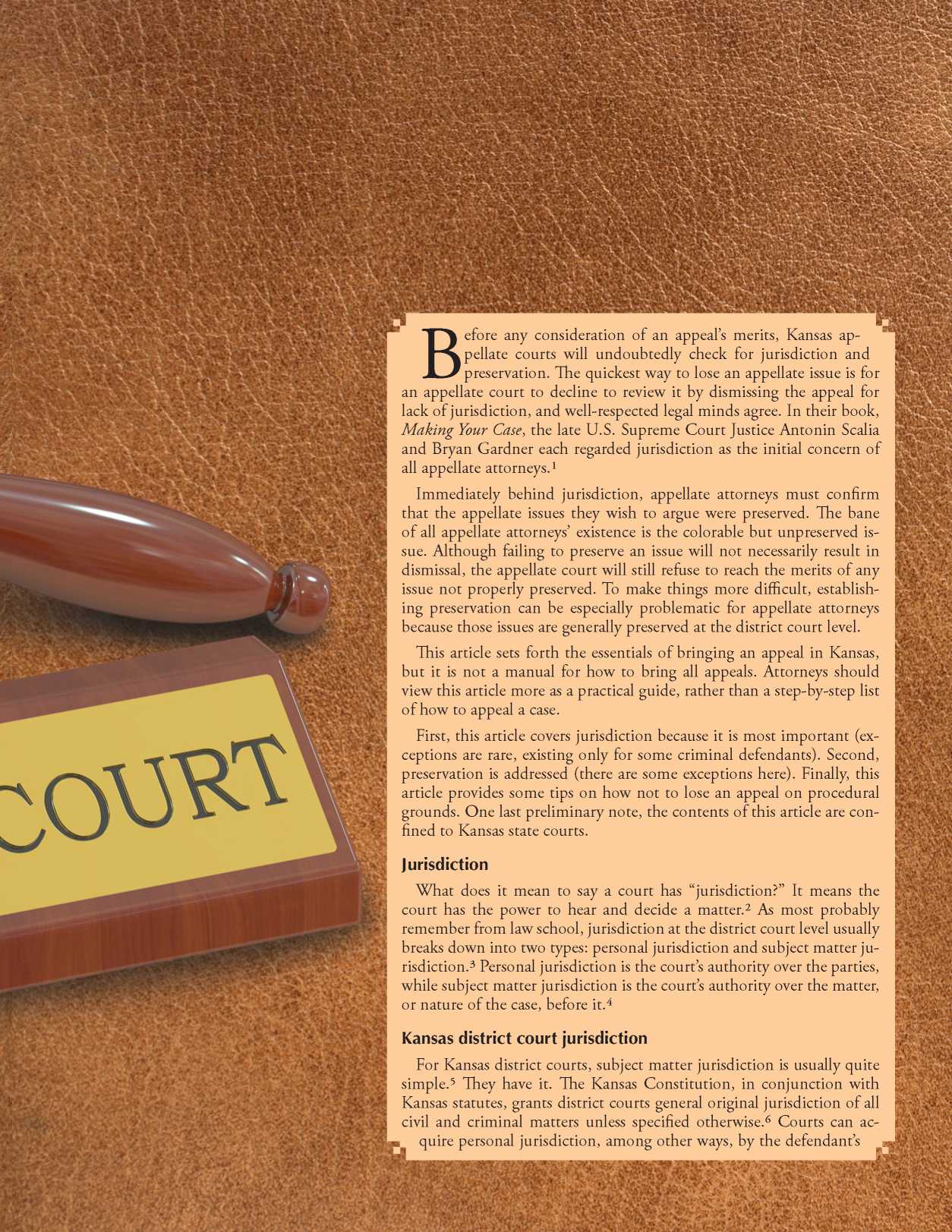Getting to the Merits Kansas Appeals: Jurisdiction, Preservation and More
| Publication year | 2019 |
| Pages | 32 |
By James Latta


Before any consideration of an appeal’s merits, Kansas appellate courts will undoubtedly check for jurisdiction and preservation. The quickest way to lose an appellate issue is for an appellate court to decline to review it by dismissing the appeal for lack of jurisdiction, and well-respected legal minds agree. In their book, Making Your Case, the late U.S. Supreme Court Justice Antonin Scalia and Bryan Gardner each regarded jurisdiction as the initial concern of all appellate attorneys.[1]
Immediately behind jurisdiction, appellate attorneys must confirm that the appellate issues they wish to argue were preserved. The bane of all appellate attorneys’ existence is the colorable but unpreserved issue. Although failing to preserve an issue will not necessarily result in dismissal, the appellate court will still refuse to reach the merits of any issue not properly preserved. To make things more difficult, establishing preservation can be especially problematic for appellate attorneys because those issues are generally preserved at the district court level.
This article sets forth the essentials of bringing an appeal in Kansas, but it is not a manual for how to bring all appeals. Attorneys should view this article more as a practical guide, rather than a step-by-step list of how to appeal a case.
First, this article covers jurisdiction because it is most important (exceptions are rare, existing only for some criminal defendants). Second, preservation is addressed (there are some exceptions here). Finally, this article provides some tips on how not to lose an appeal on procedural grounds. One last preliminary note, the contents of this article are confined to Kansas state courts.
Jurisdiction
What does it mean to say a court has “jurisdiction?” It means the court has the power to hear and decide a matter.[2] As most probably remember from law school, jurisdiction at the district court level usually breaks down into two types: personal jurisdiction and subject matter jurisdiction. [3] Personal jurisdiction is the court’s authority over the parties, while subject matter jurisdiction is the court’s authority over the matter, or nature of the case, before it.[4]
Kansas district court jurisdiction
For Kansas district courts, subject matter jurisdiction is usually quite simple.[5] They have it. The Kansas Constitution, in conjunction with Kansas statutes, grants district courts general original jurisdiction of all civil and criminal matters unless specified otherwise.[6] Courts can acquire personal jurisdiction, among other ways, by the defendant’s appearance (actually showing up in court or filing a responsive pleading)[7] by the defendant's being served[8] or by the defendant's waiving personal jurisdiction.[9] As a reminder, courts always have personal jurisdiction over the party initiating the case,[10] and subject matter jurisdiction cannot be achieved by waiver or consent.[11] Most important for appellate purposes, if a district court lacks jurisdiction for any reason when ruling on a matter, an appellate court cannot procure jurisdiction over that specific ruling.[12] In other words, the appellate court will dismiss the case without reaching the merits.
Appellate court jurisdiction
Unlike the constitutional grant of jurisdiction to Kansas district courts,[13] no similar right exists for appellate jurisdiction.[14] Neither the Kansas Constitution nor the United States Constitution grants the right to an appeal.[15] Instead, the Kansas legislature has furnished all parties the statutory right to an appeal.[16] When an appeal is not taken in accordance with these jurisdictional statutes, Kansas appellate courts lack jurisdiction over a case and must dismiss it.[17] And in contrast to most other aspects of our adversarial system, appellate courts "have a duty to question jurisdiction on [their] own initiative."[18] So even if opposing counsel misses the fact that appellate jurisdiction does not exist, an appellate court will surely catch it and sua sponte raise the issue on appeal.
With that background in mind, civil appeals will be discussed first, then criminal appeals.
Civil appeals
K.S.A. 60-2102(a) lists several instances in which a party may bring an appeal. Most commonly, an appellant may bring an appeal as a matter of right from a "final decision."[19] The problem with appealing a "final decision" is discerning what constitutes a final decision. The legislature did not define "final decision," but the Kansas Supreme Court has construed a "final decision" to mean "one which finally decides and disposes of the entire merits of the controversy, and reserves no further questions or directions for the future or further action of the court."[20] The purpose behind this rule is that piecemeal appeals are discouraged.[21] To help determine whether a final decision was issued, one asks whether the decision terminated a right at issue or refused a remedy as a terminal act.[22]
For example, a grant of summary judgment in total is a final decision.[23] Denial of summary judgment is not a final deci-sion,[24] and a grant of partial summary judgment is not a final decision until the remaining issues are resolved.[25] When the only issues left for the district court to resolve are attorney fees and costs, regardless of whether the court eventually grants them, the district court has issued a final decision.[26]
A district court, however, can transform an interlocutory decision into an appealable decision with seven magic words: "[T]here is no just reason for delay," or something along those lines.[27] Courts often refer to this as 254(b) certifications, after the statute codifying the rule that allows an appeal before every remaining issue is decided.[28] In addition to the requirement that the court state there is no just reason for delay, the court must also expressly state that the entry of judgment is a final judgment.[29]
When both requirements are present, the party on the "wrong side" of the judgment may instantaneously appeal the rulings that were 254(b) certified.[30] Notably, a 254(b) certification starts the running of the appellate time clock.[31] Following a 254(b) certification, the appellant has thirty days to file a notice of appeal for the issues the court ruled on (appellate deadlines will be discussed in more detail below).[32]
Once a final decision is issued, the countdown to appeal begins to run when the district court files the journal entry of judgment. In particular, a district court's judgment becomes effective when the court signs a written journal entry memorializing the judgment and files the journal entry with the clerk.[33] As a matter of practicality, all that matters is the filed, written journal entry for an appellant to know when a final judgment occurred.[34] In civil cases, the appellant must file the notice of appeal within thirty days of the district court filing the journal entry of judgment.[35] To be clear, the date of filing controls, not the date the court signs the journal entry (these two dates often vary).[36]
Sometimes, though, the district court pronounces its judgment from the bench, which it later memorializes in a written journal entry. In that case, the date of filing still controls.[37] Nonetheless, there are two options as to when to file the notice of appeal. One, the appellant may file a premature notice of appeal (filing after pronouncement from the bench but prior to the filing of the written journal entry), as allowed by Kansas Supreme Court Rule 2.03. Once the district court files the written journal entry, the premature notice of appeal morphs into a valid notice of appeal without any additional work by the appellant.[38] Or two, the appellant may wait to file until the written journal entry is filed with the clerk.[39] In any event, filing a notice of appeal before pronouncement of judgment is too premature to become valid later–that is, the notice of appeal is and will always be invalid.[40]
Post-judgment motions will toll the thirty-day time limit, but those motions must be timely.[41] To be timely, a party must file a post-judgment motion within twenty-eight days of the entry of judgment.[42] K.S.A. 60-2103(a) lists the post-judgment motions that will toll the time to appeal: judgment as a matter of law, amend findings, new trial, and alter/amend judgment. Plus, a motion to reconsider tolls the deadline to appeal because it is equivalent to a motion to alter or amend judgment.[43] If a post-judgment motion is not found in K.S.A. 60-2103, other than a motion to reconsider, the motion will not toll the deadline.[44]
Following the district court's denial of a post-judgment motion, the clock to appeal resets to thirty days.[45] If the time limits are missed, appellate courts are without jurisdiction to hear the appeal.[46] Even if the district court errs by providing trial counsel with the incorrect time frame to appeal, causing trial counsel to file a late appeal, counsel has nevertheless blundered.[47] Kansas appellate courts strictly enforce the jurisdictional deadlines to file an appeal, no matter the circum-stances.[48] Returning to premature notices of appeal, a notice of appeal filed after a post-judgment motion was filed, but before the motion is denied, ripens into a valid notice of appeal after the denial (if the motion is granted, of course, the appeal becomes moot).[49]
After a final decision, after filing post-judgment motions, and after determining the last day to appeal, appellants must file the notice of appeal with the district court that issued the judgment. In the notice of appeal, appellants must specify who is taking the appeal, what they are appealing, and where they are taking the appeal.[50] Who is appealing...
To continue reading
Request your trial
